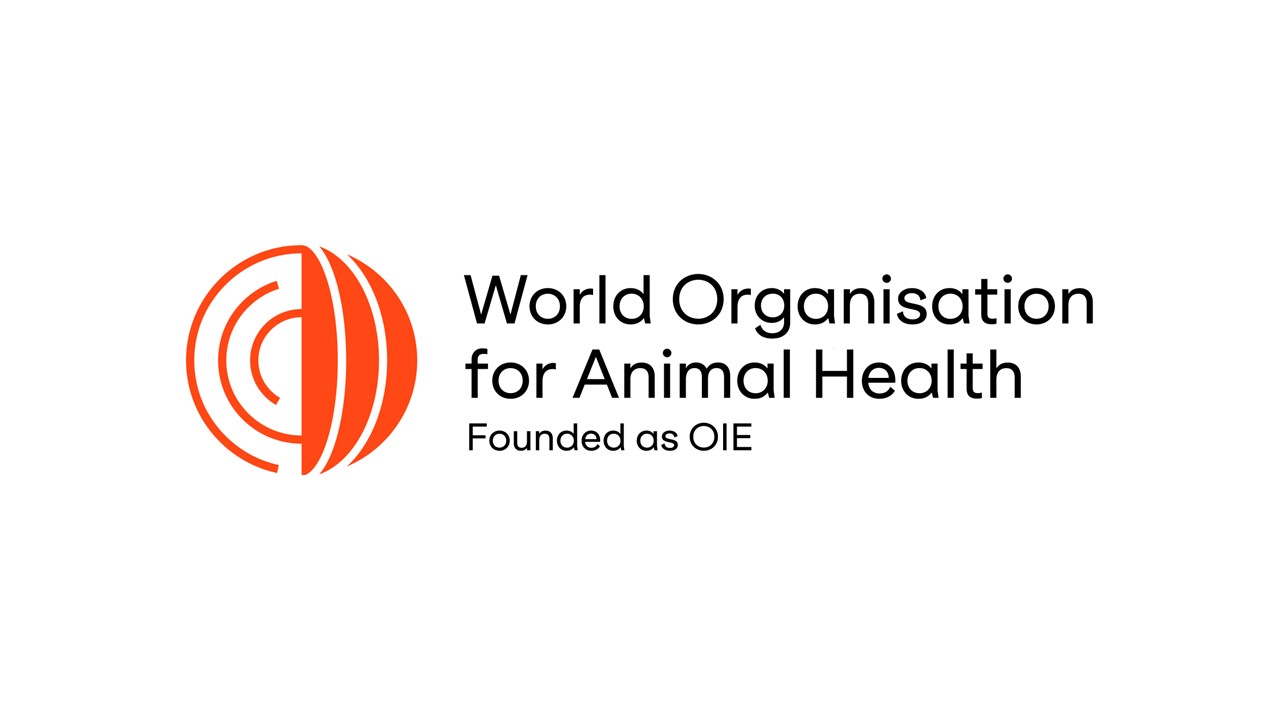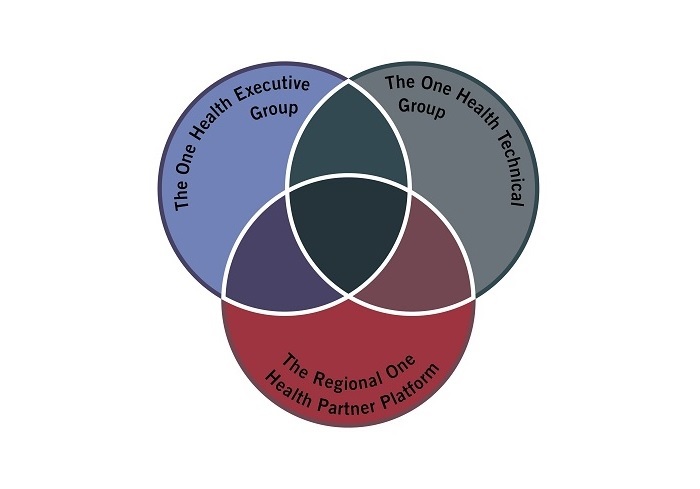
Food and Agriculture Organization of the United Nations (FAO)
World Organisation for Animal Health (WOAH, founded as OIE)
World Health Organization (WHO)
United Nations Environment Programme (UNEP)
The “One Health” concept summarized the idea that had been known for more than a century; that human health and animal health are interdependent and bound to the health of the ecosystems in which they exist.
The Regional One Health Coordination Mechanism for Europe consolidates cooperation between the regional offices of the FAO, the WOAH, the WHO and the UNEP for the European Region (including Central Asia) to address the wide range of activities related to One Health concept, within the human-animal-environment interface.
This framework was formally established in April 2021 when the Heads of the FAO, the WOAH and the WHO Regional Representations for Europe and Central Asia signed a Joint Statement to coordinate One Health priorities in the Region. In August 2022, Regional Office of UNEP for Europe joined Regional One Health mechanism, and regional representatives (directors) of four originations signed a new Joint Statement of Intent to coordinate One Health Activities in Europe and Central Asia, creating Regional Quadripartite Mechanism for Europe.
Three international organisations – the Tripartite Alliance – have worked together for many years to prevent, detect, control and eliminate health threats to humans, originating – directly or indirectly – from animals. Now, after UNEP jouined the Tripartite, the global Quadripartite Alliance is the basement for the Regional One Health Coordination Mechanism.
In 2010, the three Organisations published the Tripartite Concept Note, describing principles of their collaboration and objectives.
In October 2017, the WOAH, the FAO and the WHO released their second Tripartite strategic document reaffirming their commitment to provide multi-sectoral, collaborative leadership in addressing health challenges. On 31 May 2018, partners signed a Memorandum of Understanding (MOU).
The One Health High-Level Expert Panel (OHHLEP) was formed in May 2021 to advise FAO, UNEP, WHO and WOAH on One Health issues. This includes recommendations for research on emerging disease threats, and the development of a long-term global plan of action to avert outbreaks of diseases like H5N1 avian influenza, MERS, Ebola, Zika, and, possibly, COVID-19. The panel will also have a role in investigating the impact of human activity on the environment and wildlife habitats, and how this drives disease threats. Critical areas include food production and distribution, urbanization and infrastructure development, international travel and trade, activities that lead to biodiversity loss and climate change, and those that put increased pressure on the natural resource base – all of which can lead to the emergence of zoonotic diseases.
On 17 March 2022, the heads of the four organizations – QU Dongyu, the Director-General of FAO, Monique Eloit, the Director-General of WOAH, Inger Anderson, the Executive Director of UNEP, and Tedros Adhanom Ghebreyesus, the Director-General of WHO -signed a Memorandum of Understanding (MoU) for joint One Health works, by which UNEP joined the former Tripartite (FAO, WOAH and WHO) as an equal partner to form a new Quadripartite Collaboration for One Health. By this, four organization have signed a groundbreaking agreement to strengthen cooperation to sustainably balance and optimize the health of humans, animals, plants and the environment.
The new Quadripartite MoU provides a legal and formal framework for the four organizations to tackle the challenges at the human, animal, plant and ecosystem interface using a more integrated and coordinated approach. This framework will also contribute to reinforce national and regional health systems and services.
The Regional One Health Coordination Mechanism for Europe consists of three layers: the One Health Executive Group, the One Health Technical Group and the Regional One Health Partner Platform for Europe. The Platform convenes multiple partners from various sectors including other UN agencies, international organizations, Member State representatives, academia, private sector representatives and civil society.
The One Health Executive Group (OHEG) for Europe comprises the respective Regional Heads of the Quadripartite (FAO, WOAH, WHO, UNEP) or their designated Directors, or Regional Representatives.
The OHEG is accountable for decision-making, providing strategic direction and support to global and regional competent governance structures and aligning the regional work in the global efforts on the One Health.
The One Health Technical Group for Europe (OHTG) is practically a Secretariat of the Regional One Health Coordination Mechanism.
The Group comprises liaison officers from FAO, WOAH, WHO and relevant technical staff. The Group provides coordination and implementation of joint regional actions by the Quadripartite, including joint resource mobilization, setting agenda, sharing information.
OHEG established the Regional One Health Partner Platform as a third part of the Regional One Health Coordination Mechanism, with aim to involve major partners and stakeholders, including representatives of competent authorities from Members and to increase effectiveness of the Mechanism.
The objective of the Partner Platform is to support and provide input to the work of the OHEG and OHTG to maximize country impact. The Platform takes stock of emerging and re-emerging health threats in the human-animal-environment interface in the region and provide evidence, share lessons learned and identify priorities for potential joint action by the Tripartite and its partners.
The One Health approach is particularly relevant to address issues associated with zoonotic diseases, antimicrobial resistance (AMR), food safety and biosecurity, biodiversity loss and climate change.
In 2011 the FAO, the WOAH and the WHO set three priority areas of the global Quadripartite Alliance: animal influenza, antimicrobial resistance and rabies.
WOAH Antimicrobial Resistance Portal
Joint Statement to coordinate One Health priorities in the Region
Terms of References of the Regional One Health Coordination Mechanism
Migrating Eurasian wigeon (Anas penelope) ducks are leaving for the southern hibernating areas in autumn and winter.
In 2005 the WOAH and the FAO established a global network of expertise on animal influenza – OFFLU.
This network of international experts is intended to monitor influenza in humans more effectively, in issues related to the animal–human interface. Since 2009 it has extended its field of action to all animal influenzas and continues to increase its activities.
In particular, OFFLU collaborates with WHO to contribute to the early preparation of human vaccines
944376422
Rabies still kills tens of thousands of people every year. However, we have all the methods needed to prevent and eliminate this disease.
The Tripartite Alliance in collaboration with the Global Alliance for Rabies Control has developed the Global Strategic Plan to end human deaths from dog-mediated rabies by 2030.
Antimicrobial agents are medicines used to treat infections, particularly those of bacterial origin. These medicines are essential to protect human and animal health, as well as animal welfare. Excessive or inappropriate use can lead to the emergence of resistant bacteria which do not respond to antibiotic treatment, as seen in recent decades.
This phenomenon, called antimicrobial resistance, which poses a threat to disease control throughout the world, is a primary concern for human and animal health, and it is the focus of the WOAH AMR Working Group.
The WOAH has worked actively for more than ten years on the issue of veterinary products (including antimicrobial agents) and developed a coherent strategy for its activities in this area and a list of antimicrobial agents of veterinary importance, in parallel with the WHO list for human medicine.
Nepal jungle area at the foot of the Annapurna
Biodiversity – this term refers to the idea of living variation, from genes and traits, to species, and to ecosystems. Biodiversity is crucial for normal ecosystems functioning and ecosystems services: nutrient and water cycling, plant pollination, climate regulation and pest and pollution control. Rapid biodiversity loss leads to negative consequences for animal, human and environmental health.
The current species extinction rate is estimated to be between 1,000 and 10,000 times higher than the natural or ‘background’ rate, according to the International Union for Conservation of Nature5.
One in four mammals and one in eight birds face a high risk of extinction in the near future. The total number of known threatened animal species has increased from 5,205 to 8,462 since 19965.
Biodiversity loss increases the probability of zoonotic diseases outbreaks due to the loss of “dilution effect’. One example is research conducted by American ecologists Richard S. Ostfeld and Felicia Keesing in 2012 regarding the ecology of Lyme disease6.
One host, the white-footed mouse, is more competent at transmitting the bacteria, that causes Lyme disease, to biting Ixodes ticks than other small-mammal hosts. If population density of white-footed mouse is high and diversity of other hosts of Lyme disease bacteria is low, the probability of ticks to become infected is very high. So, the diversity of other vertebrate hosts provides dampening or ‘dilution’ effect and protects humans against exposure to Lyme disease.
Another actual issue of biodiversity loss – dramatic global decrease in bee populations. According to the European Parliament in recent years beekeepers have reported colony losses in France, Belgium, Germany, the UK, Italy, Spain, the Netherlands and another countries.
Among major reasons of bees’ extinction: land-use changes for agriculture or urbanization, which leads to homogenous landscapes and the disappearance of diverse flora, non-sustainable usage of pesticides, invasive species and diseases, and climate change.
5. THE IUCN RED LIST OF THREATENED SPECIES™. Species Extinction – The Facts.
A giant piece of Ice breaks off the Perito Moreno Glacier in Patagonia, Argentina
Climate change increases the risk of human and animal exposure to different infectious diseases.
In 2008, the Wildlife Conservation Society released a report called “Deadly Dozen” – a list of 12 pathogens which could spread into new regions as a result of climate change. It includes: Avian Influenza, Babesiosis, Cholera, Ebola, intestinal and external parasites, Lyme disease, Plague, Rift Valley Fever, sleeping sickness, Tuberculosis and Yellow Fever. It also includes harmful algal blooms.
Climate change leads to increased incidences of foodborne pathogens, such as Salmonella spp. and Campylobacter spp6
6. FAO publication “Climate change: Unpacking the burden on food safety”
WOAH Regional One Health webpage
From all the lessons that COVID-19 has taught us, one appears clearer than ever: we are stronger together. There is a need for collaboration to battle shared challenges.
The continuous emergence of health threats originating in the animal, human and environment interface urges the Tripartite (FAO, WOAH and WHO) to reassess, renew and scale-up support to countries to prevent, detect, assess and manage potential health threats with the aim of protecting the health of animals and people, avoiding economic disruptions, and sustaining livelihoods.
In the video below, representatives of the World Organisation for Animal Health, the Food and Agriculture Organization of the UN, the World Health Organization, and the UN Environment Programme highlight the need for collaboration to battle shared challenges.









